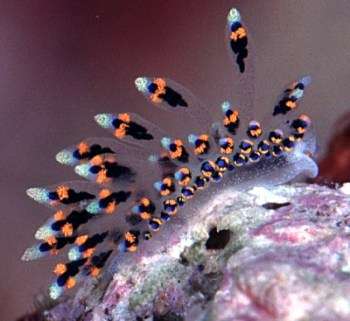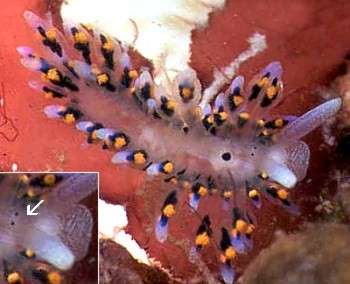

Costasiella? sp. 2.
Order: SACOGLOSSA
Superfamily: LIMAPONTIOIDEA
Family: Costasiellidae
DISTRIBUTION
Indo-West Pacific.
PHOTO
UPPER: Kerama Is., near Okinawa, Japan.,3m depth on a rock covered with brown algae. 7mm long. PHOTO: Atsushi Ono.
LOWER: Pulau Kaledupa, Tukang Besi Archipelago, SE Sulawesi, Indonesia, 18 May 1999 on dead table coral covered in algal growth. Depth: 6m. Size: 6mm. PHOTO: Lindsay Warren.
This animal has similarities to an aeolid, a Janolus and a sacoglossan. See the discussion in the messages below. The consensus seems to agree that it is a sacoglossan, and the close set eyes suggest a species of Costasiella. Points of importance are grooved rhinophores, the eyes close together, the 'melanin gland' (black spot behind the eyes and in front of the pericardial sac).
Authorship detailsRudman, W.B., 2000 (February 28) Costasiella? sp. 2. [In] Sea Slug Forum. Australian Museum, Sydney. Available from http://www.seaslugforum.net/find/costsp2
Related messages
Costasiella from Tufi - Papua New Guinea
March 8, 2003
From: Dave Harasti

Hi Bill,
I have attached another species that I am unsure of it's identification. This species was found under Tufi Wharf in Papua New Guinea in January 2003. The animal was very small, less than 1cm and in about 3 metres of 30 degree water.
Cheers,
Dave Harasti
www.webone.com.au/~diving
diving@webone.com.au
Harasti, D., 2003 (Mar 8) Costasiella from Tufi - Papua New Guinea. [Message in] Sea Slug Forum. Australian Museum, Sydney. Available from http://www.seaslugforum.net/find/9250Dear Dave,
This is a little unnamed sacoglossan belonging to the genus Costasiella. It is called Costasiella sp. 2 on the Forum.
Best wishes,
Bill Rudman
Re: Aeolid? Janolus? Stiliger? from Sulawesi
April 9, 2000
From: Kathe R. Jensen
Dear Bill and others,
Clay Carlson directed my attention to the photos of Costasiella? sp. 2 (which appeared at the time when I was still trying to get settled here in Thailand). After looking at all the pictures (you are right, that is a lot of pictures of such a small beast), I can understand the doubts of various people about the ID. However, I am mostly inclined to agreeing with the Costasiella placement. I have one undescribed species collected in Guam and also in Phuket, Thailand, in which the eyes are also behind the rhinophores. That species is very darkly pigmented, and it looks like the eyes are in little white "goggles", which must mean that they are some distance apart (namely 2 white rings). That species also has orange glands at the bases of the cerata. Unfortunately I do not have slide-scanning facility here, so I cannot attach a picture. It looks to me like your Costasiella sp. 2 has long stalks to the cerata with unbranched tubule of digestive gland, and that the dark lobules of the digestive gland (characteristic of other species of Costasiella as well) occur only in the outer part of the cerata. It certainly is an interesting little "feller", and I look forwards to hearing of anybody finding it on an identifiable alga (apparently nobody has found it on Avrainvillea, which is the most common food for this genus), and for somebody taking a look at its radula (if it is a Costasiella, the teeth should be small, narrow blade-shaped - and be of almost uniform size along the radular ribbon).
Kathe R. Jensen
jensen@ait.ac.th
Jensen, K. R., 2000 (Apr 9) Re: Aeolid? Janolus? Stiliger? from Sulawesi. [Message in] Sea Slug Forum. Australian Museum, Sydney. Available from http://www.seaslugforum.net/find/2242Thanks Kathe,
I can contact you know. I've added your new email to your entry on the Participants List.
Bill Rudman.
Costasiella? sp. 2 from Marshall Ids
March 4, 2000
From: Scott Johnson

Hi Bill,
Adding one more picture to the pot, it looks like Costasiella? sp. 2 is also found in the Marshalls. These were not uncommon at Enewetak but are less common here at Kwajalein.
Scott
johnson@kmr.ll.mit.edu
Johnson, S., 2000 (Mar 4) Costasiella? sp. 2 from Marshall Ids. [Message in] Sea Slug Forum. Australian Museum, Sydney. Available from http://www.seaslugforum.net/find/2016Thanks Scott,
From your photo, the yellow marks in the cerata seem to be little glands
best wishes,
Bill Rudman.
Re: Aeolid? Janolus? Stiliger? from Sulawesi
February 29, 2000
From: C. Carlson & P.J. Hoff

Bill,
Our guess on this beast would be Stiliger -- at least Sacoglossa
Details: el83 8.5mm; Palau, [Nikko Hotel], reef flat; 5 August 1978.
We have this animal from both Palau and Pohnpei. Our notes on the Palau animal say "rhinophores grooved their entire length".
Using a hotel for a site name is not a good idea. This one has changed names a couple of times --we just haven't bothered to get the Palauan name for the area.
Clay Carlson & Patty Jo Hoff
Merizo, Guam
clay.carlson@kuentos.guam.net
Carlson, C. & Hoff, P.J., 2000 (Feb 29) Re: Aeolid? Janolus? Stiliger? from Sulawesi. [Message in] Sea Slug Forum. Australian Museum, Sydney. Available from http://www.seaslugforum.net/find/1989Dear Clay & Patty Jo,
For such a little animal it's certainly been photographed a few times! The grooved rhinophores are another good clue to its relationships. The eyes, so close together in the dorsal midline, behind the rhinophores, is characteristic of Costasiella. Another interesting feature clearly seen in your photo is a black spot behind the eyes and in front of the pericardial sac. Burn (1998) in Mollusca: the Southern Synthesis states that species of Costasiella have a 'melanin gland' near the anus, in front of the pericardium, just where the black spot occurs in your animal.
I am fairly confident now that this is a species of Costasiella. I've even taken the plunge and made a separate page for it. Would you agree?
Bill Rudman.
Re: Costasiella sp. 2.
February 29, 2000
From: C. Carlson & P.J. Hoff
Bill
At this point we would not go along with your suggestion to put the beast in the genus Costasiella. We have 11 species of Costasiella in our collection. The eyes are relatively larger, closer together and between the rhinophores (except possibly in one case). None of those in our collection show any sign of bulbous cerata, nor clear cerata. The general body length would also make us hesitant about the Costasiella placement.
I was going to pop a buccal bulb on one of the Palau specimens but right now can't find any of the Palau 1978 material.
Clay & Patty Jo
Merizo, Guam
clay.carlson@kuentos.guam.net
Carlson, C. & Hoff, P.J., 2000 (Feb 29) Re: Costasiella sp. 2.. [Message in] Sea Slug Forum. Australian Museum, Sydney. Available from http://www.seaslugforum.net/find/1997Dear Clay & Patty Jo,
I agree it's not a comfortable fit. To show there are doubts I'll add a ? to the name and wait until we get some solid anatomy to work with.
Cheers,
Bill Rudman.
Re: Aeolid? Janolus? Stiliger? from Sulawesi
February 28, 2000
From: Cory Pittman

Dear Bill,
Here's a photo of an animal that appears to be the same species from Hekili Point, Maui, Hawaii. It was 7 mm in length and autotomized a few of its longer dorsal cerata before it was photographed. I picked it up in an algae wash from a depth of less than 1 m in an area of mixed rubble/coral/sand on Nov. 23, 1997. It was only the second specimen we'd seen (the first was found under a rock by Pauline Fiene at a depth of about 12 m off Kihei, Maui). We've been tentatively listing it as a Stiliger but, after noticing the closely spaced eye spots while writing this, I suspect it may actually be a Costasiella. There's no sign of a crest between the rhinophores.
Best wishes,
Cory
cory@cet.cet.com
Pittman, C., 2000 (Feb 28) Re: Aeolid? Janolus? Stiliger? from Sulawesi. [Message in] Sea Slug Forum. Australian Museum, Sydney. Available from http://www.seaslugforum.net/find/1983Dear Cory,
Thanks for the input. A species of Costasiella is a most reasonable solution. A quick look at its radula would easily resolve the matter.
Best wishes,
Bill Rudman.
Aeolid? Janolus? Stiliger? from Japan
February 27, 2000
From: Atsushi Ono


Dear Bill,
Thank you for ID of F. rubrolineata.
Here is beautiful Sacoglossa species.
I found this at 3m depth on a rock covered with brown algae. This animal is 7mm long.
The cerata looks like fireworks. I cannot see any sign of rhinophores
This is very rare species in Kerama Is. [near Okinawa, Japan]. I have seen only one individual.
Could you help me to identify this?
Sincerely,
Atsushi Ono.
ononini@cosmos.ne.jp
Ono, A., 2000 (Feb 27) Aeolid? Janolus? Stiliger? from Japan. [Message in] Sea Slug Forum. Australian Museum, Sydney. Available from http://www.seaslugforum.net/find/1977Dear Atsushi,
I agree from your photos that this beautiful animal looks like a sacoglossan. However by remarkable coincidence I have just received a message from Lindsay Warren with photos of the same animal from Sulawesi in Indonesia. In her photos the rhinophores are clearly visible and their is a crest between them characteristic of Janolus. Perhaps the rhinophores were damged in your animal. However, as I say in her message, I am not sure whether this is an aeolid, sacoglossan or janolid. hopefully someone will recognise it and let us know.
Best wishes,
Bill Rudman
Aeolid? Janolus? Stiliger? from Sulawesi
February 27, 2000
From: Lindsay Warren


Dear Bill
The two attached shots are of a beautiful unidentified aeolid found by Rich Smith at 11am on 18 May 1999 on dead table coral covered in algal growth. Depth: 6 m. Size: 6 mm. Pulau Kaledupa, Tukang Besi Archipelago, SE Sulawesi, Indonesia. [Operation Wallacea].
The overall body colour is translucent white with fine white speckling towards the front which also features on the quite long, simple rhinophores. The cerata down each side of the body which come together at the posterior end are quite distinctive with black and orange internal areas and blue tips. Two small eye spots are visible close together behind the rhinophores and there is a larger black spot further back on the notum.
Photos: Lindsay Warren
Any idea as to what it might be?
All the best
Lindsay Warren
100014.2112@compuserve.com
Warren, L., 2000 (Feb 27) Aeolid? Janolus? Stiliger? from Sulawesi. [Message in] Sea Slug Forum. Australian Museum, Sydney. Available from http://www.seaslugforum.net/find/1979Dear Lindsay,
I don't think this is an aeolid. The eyes on a hump behind the rhinophores is an unusual placement for aeolid eyes. Also the lack of oral tentacles is very unusual. One thing that does interest me is that in one photo there seems to be a crest between the rhinophores which could suggest something related to Janolus. That is not altogether satisfactory because Janolus usually has perfoliate, not smooth, rhinophores, and the cerata usually go around the front of the body.
By coincidence Atsushi Ono just sent photos of what seems to be the same animal from Japan. He suggested it was a sacoglossan which is also a possibility. It could be a Stiliger or Costasiella. If so the black spot you enquire about behind the eyes could be the anus.
At this stage I am not sure. The size of the animals could suggest we are looking at juveniles which could complicate the matter. Let's see if someone can help.
Best wishes,
Bill Rudman.
